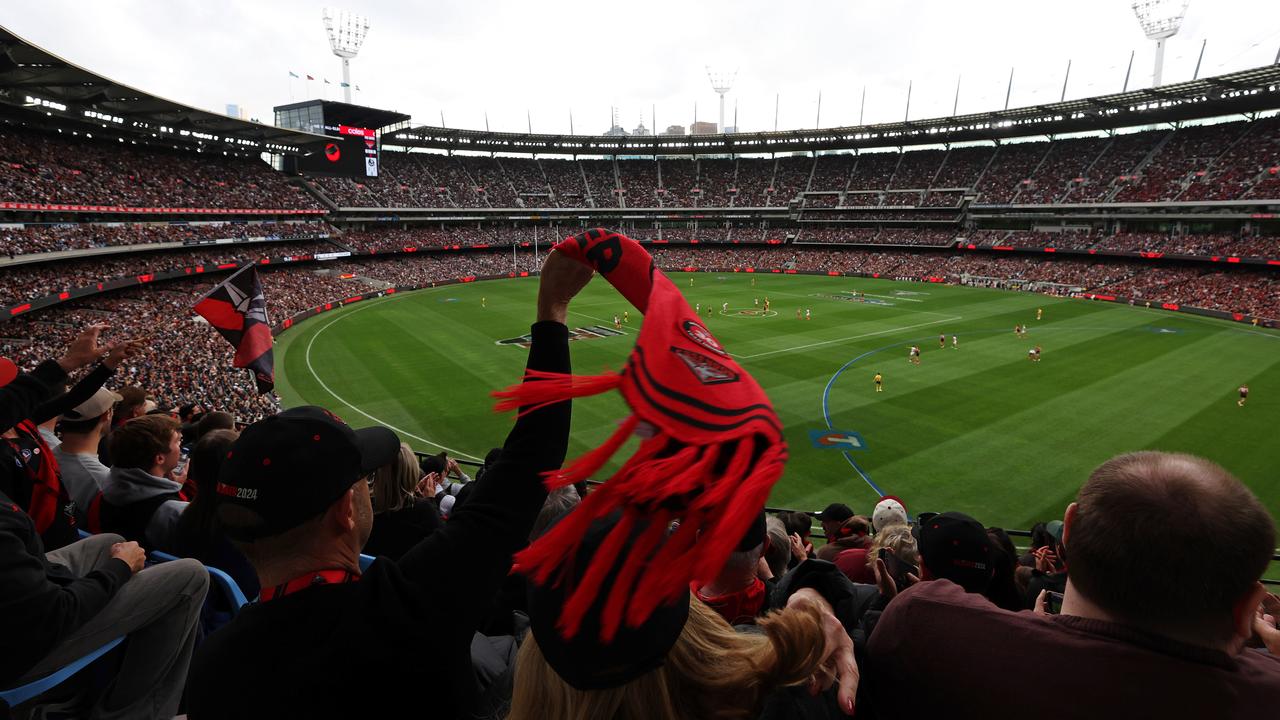Good Friday Appeal 2025: Little faces of courage ready to inspire Victoria
The state’s littlest fighters are set to benefit from the generosity of Victorians as the Good Friday Appeal kicks off.
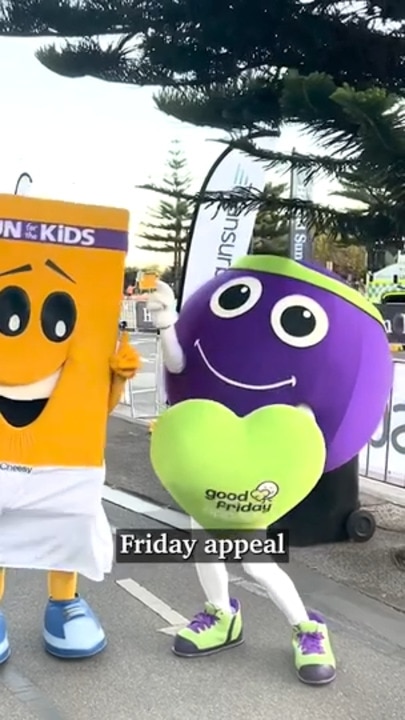
Victoria
Don't miss out on the headlines from Victoria. Followed categories will be added to My News.
The state’s littlest fighters are set to benefit from the generosity of Victorians as the 2025 Good Friday Appeal kicks off.
The Appeal, supported by the Herald Sun and Channel 7, has raised an extraordinary $468m for the Royal Children's Hospital. Last year’s appeal raised $23m.
Funds raised by the appeal will further transform care at the Royal Children’s Hospital by supporting vital programs, research and equipment.
To donate, visit goodfridayappeal.com.au
Charlie celebrates magic milestone in cancer battle
It’s not the first or last time he’ll make his mother cry.
But the happy tears for Charlie, 2, followed an intense 10 months of surgeries, chemotherapy and radiation therapy to fight Wilms tumour, a rare kidney cancer.
Charlie’s mother, Paige, said a call from her son’s daycare, mentioning a hard lump on his tummy, set off a nightmare ride.
It was May 2024.
A visit to the doctor, then hospital for an X-ray and ultrasound found a mass on one of Charlie’s kidneys.
He was sent to the Royal Children’s Hospital which confirmed Charlie had Wilms tumour.
“Your world just stops,” Paige said. “When you’re an outsider, and you see a kid with cancer, your heart breaks, and you think, ‘I couldn’t even imagine being in that position.’ But when it happens to you, it’s like, this is your life, and you need to get on with it.
“It changes your perspective on everything. It’s devastating watching your child go through something so harsh and hard. No kid should experience that. But I’m so proud of how well he’s handled it.”


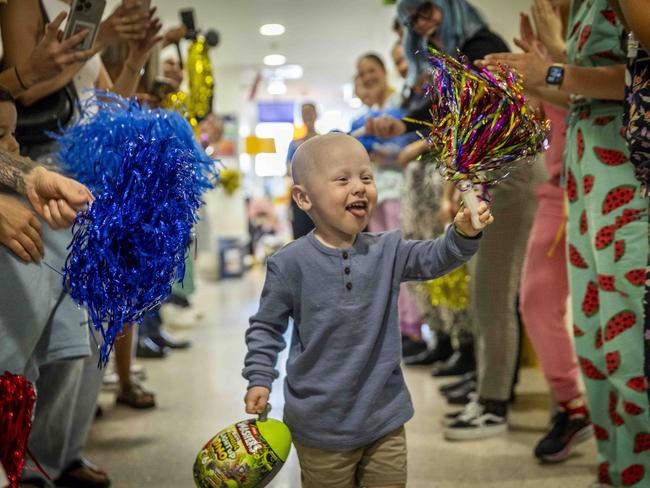

Paige said Charlie’s initial treatment included four weeks of chemotherapy before surgeons removed a kidney and the tumour.
“They told us the cancer was stage three, so we started a different program and treatment plan, which ended up being the highest dose of chemo he could have,” Paige said.
She said Charlie also underwent radiation therapy, and two surgeries to check a mark on his chest, which turned out to be a lymph node.
Paige said Charlie was “too young and unaware of what was going on” when he first started treatment. But as he got older, fear and trauma began creeping in.
“He’s been a real champion, but he knows when the car is driving to him to get treatment. He’ll say, ‘No hospital, mummy. I want to stay home.’ It’s hard when he begs you not to go in. But I always tell him, ‘We want to make you better.’”
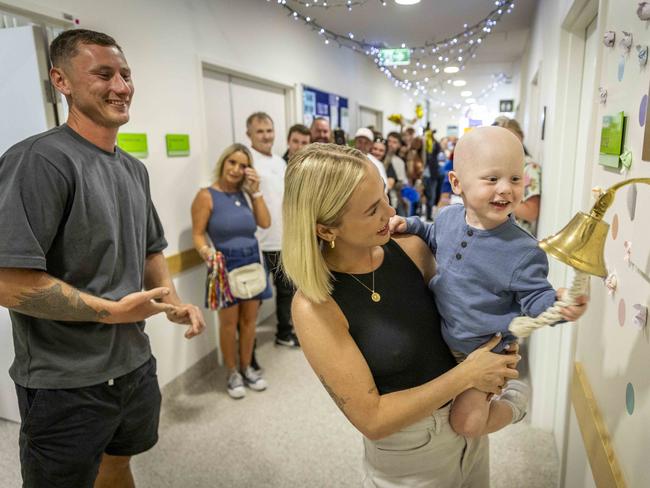
Last week, Charlie entered a new chapter in his journey. He rang the bell at the RCH, signifying he had completed a round of cancer treatment.
“When you first get that diagnosis, it feels like the end will never come. It feels so far away,” Paige said. When you actually get to the end, you feel so grateful. You get to a point where you can say, He’s OK. We made it.”
Family, friends, nurses and doctors lined the ward for Charlie’s charge towards the symbolic chime. He rang it with purpose as Paige cheered for her son, and smiled through the tears.
They had made it.

Paige acknowledged the angels at the RCH.
“They make every day in so much easier for us. You come here, and it feels joyful, even though you’re going through the worst situation you could imagine. Every child here feels loved and seen,” she said.
She is thrilled that Charlie can start his life again.
“Charlie has a big personality and he’s a bundle of joy. He’s the definition of sunshine,” Paige said. “He’s my whole world.”
Ava faces battles with quiet strength
Her sparkling eyes don’t tell the whole story. For Ava, 2, and her mother Jessica, that truth is heartbreaking.
Jessica took her daughter to a doctor to look at what she thought was a lazy eye. “We didn’t think anything of it,” Jessica said. “We didn’t realise what we were in for.”
Ava was diagnosed with retinoblastoma, a rare cancer, in both eyes.
She underwent immediate intense chemotherapy at the Royal Children’s Hospital.
“Unfortunately, it didn’t kill the cancer,” Jessica said, softly. “Surgeons had to do an enuculation, and remove her right eye. That was very hard. We were trying to avoid that at all costs. But (clinicians) were worried the cancer would spread.”

Ava returned to the RCH last week for another round of chemotherapy.
“She still has cancer in her left eye and it’s really close to her central vision,” Jessica said.
“It’s really hard because they can’t get too close … or it could make her blind, so we’re relying on the systematic chemo to work.”

Jessica sighs. “It’s been a really stubborn cancer to kill.”
Jessica says hope, and belief there is “light at the end of the tunnel for Ava,” is keeping her strong. “We’re just hoping one day, it will be all done, and Ava will be healthy and better,” Jessica said.
Ava’s second birthday ticked over recently. But Jessica said they kept things low key and didn’t have a party — for Ava’s sake.
“The time between her treatments is high risk,” she said. “It’s been like Covid lockdown for us. We don’t go anywhere, we don’t see anyone. We need to protect her.”

Jessica says Ava has faced her battles with a quiet strength. Her brother, Liam, 6, is also staying strong for his little sister.
“Even after she lost her eye, it didn’t faze him,” Jessica said. “He was still there, wanting to play with his baby sister, and organise a bit of mischief for both of them. They miss each other very much.”
Brave Lucas find strength from his favourite cartoon hero
His favourite Paw Patrol character, Marshall, has a catchphrase: “I’m fired up.”
Lucas, 5, found similar motivation and strength as his cartoon canine hero, during treatment at the Royal Children’s Hospital for Burkitt lymphoma, a fast-growing, aggressive type of non-Hodgkin lymphoma.
His health ordeal began after Lucas’ mother, Phuong, noticed a lump on her son’s neck.
Tests and a biopsy at the RCH confirmed Lucas had cancer.
“It was a nightmare,” Lucas’ father, Le, said. “Phuong collapsed on the floor when she was told.”
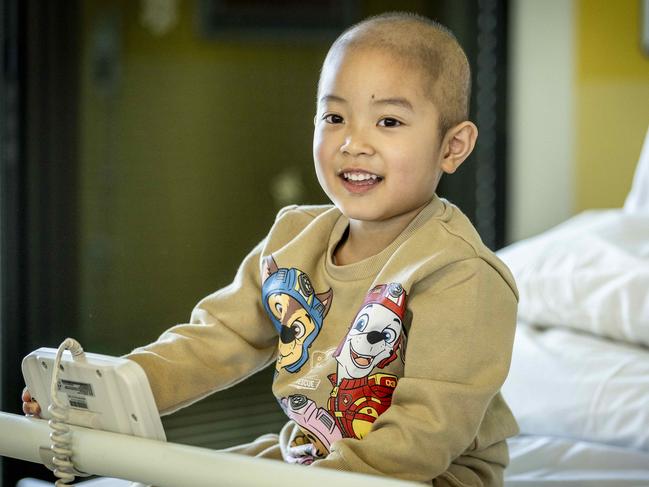
Phuong nods. “I didn’t want to say the word cancer.”
Dr Claudia Toro, an oncologist at the RCH, said Burkitt lymphoma is “quite aggressive, so we match the aggressiveness of the tumour itself with intensive therapy, and multiple cycles of chemotherapy.”
Lucas stayed in hospital for four months for treatment.
“He missed his birthday,” Dr Toro said. “He had back-to-back rounds of chemotherapy, he was attached to infusions for his nutrition … and pain relief. He needed multiple blood transfusions, and he was sick with fevers. He really had a rough trot.”
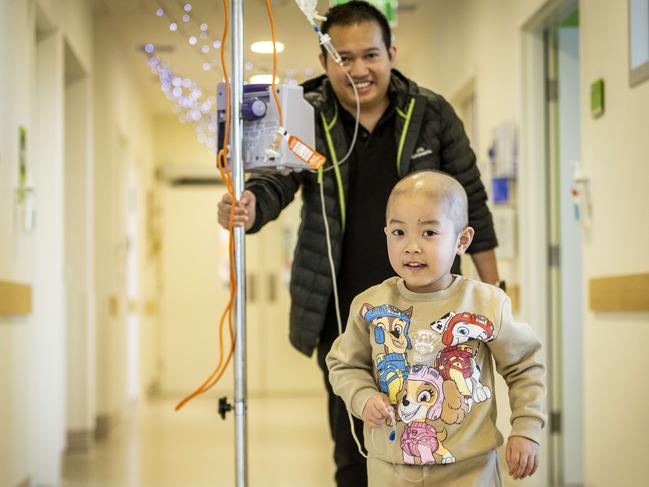
Phuong said: “He was very brave. I explained to him, ‘We’re here to fight the lump, and get the lump away from your body.’ He listened to us and he coped with the treatment.”
She said it was difficult to see their boy go through intensive treatment.
“We had to stay strong for him,” Phuong said. “Do we have any other choice? Do we have any other option? He needed us to be strong.”

Dr Toro said Lucas was brave, and added: “He’s been a really active participant in his own health care. When the doctors do their rounds every morning, and we ask him how he is, he’s the first one to pipe up and explain how he’s feeling.”
Phuong said teams at the RCH supported Lucas, as well as she and her husband.
Le added: “It’s an unlucky event, and it’s been unlucky for Lucas,’ but in other ways, we are very lucky because (the diagnosis) happened here, at the RCH.”
Lucas completed his treatment, and after four months at the RCH, finally went home.
He was also fired up for a belated birthday party.
If the hat fits, this surgeon will wear it
His scrub cap – headwear worn by a surgeon in the operating room – features a repetitive pattern of colourful bow ties. “This hat was given to me by a patient,” Professor Warwick Teague said. “It’s one of my favourites.”
But it’s not the only hat Professor Teague wears at the Royal Children’s Hospital.
His roles include consultant pediatric surgeon, lead consultant burns surgeon, and director of the RCH trauma service.
He is also a researcher, and is funded through the Murdoch Children’s Research Institute.
Professor Teague, and the parents of patients Alfie and Parker, gave permission for myself and photographer Jake Nowakowski to shadow him in the operating theatre and watch him at work as a pediatric surgeon.

That role, Professor Teague said, means he performs surgery on children “from the day they’re born … even the tiniest ones who arrive prematurely … through to a 17-year-old.”
But the multifaceted medico added: “On any given day, the hats come on and off. And that makes for a very busy schedule. People see me, and meet me, in so many roles. Some people think of me as the burns guy and, yes, I am that guy. But I’m also the research, trauma, surgeon and caring clinician guy. I need to wear all these hats, sometimes several at once.”
Alfie, six months old, was born with a rare birth defect where his oesophagus had failed to develop properly and didn’t connect to the stomach.
“He couldn’t swallow or eat anything,” Alfie’s mother Karen said.
When we met Alfie, he was about to undergo his latest surgery to stretch up the “join” Professor Teague fashioned in his oesophagus in the early days.
“We’ve been at the RCH for more of Alfie’s life than not. He’s been really tough to get through it all,” Karen said. “He’s now eating well, and we’re hoping he continues to smash the bottles.”
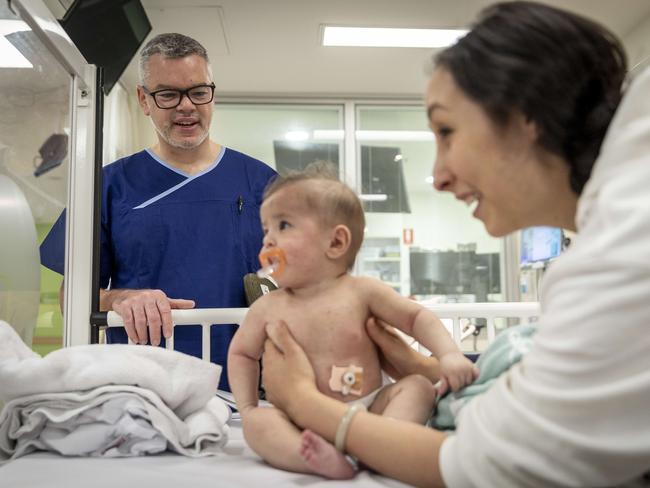
Professor Teague agreed.
“We’ve had to walk this long road together … and now we have a ‘join’ (connecting the oesophagus and stomach) which is behaving well,” he said. “But sometimes these joins start to narrow, stopping milk and food being swallowed. That means it slows down the flow. We need a wide-open join for the oesophagus to work.”
Alfie’s surgery today will include using a camera to look into his oesophagus, and gently stretching the “join” with specially-sized tubes.
“It will look like the same action is being repeated,” Professor Teague tells us. “But each tube we pass is slightly bigger than the last. of those Each step is like working up the keys of the keyboard, playing a slightly different with a bigger tube each time.”
He visits Alfie and Karen before the surgery and, soon after, huddles with a team, including an anaesthetist, nurses and other clinicians, all of whom will work together in caring for Alfie in the operating theatre.
“The huddle is about making sure everyone is aware of the activities for the day,” Professor Teague said. “That mental model needs to be shared with everyone.”
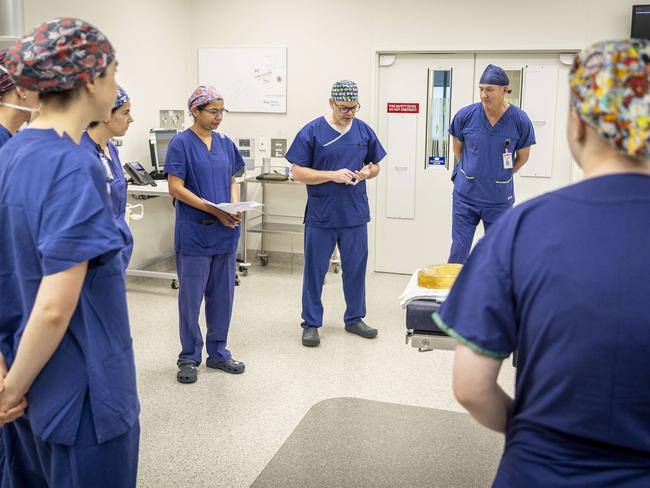
He added: “It’s like the team huddle before a sporting match. It’s that sort of moment.”
Karen and her husband Henry are grateful to Professor Teague and the RCH for saving Alfie.
They also have a daughter, Camilla, who is 3.
“Everybody here is warm and inclusive and we feel listened to, when we have concerns,” Karen said. “Warwick is very available, even though he’s extremely busy and has other patients. I’ve never felt like we’ve not been able to talk to him when we’ve needed to.”
“Eating is always going to be a challenge for Alfie,” she said. “Hopefully, his life will start to be more pleasant than what he’s been through.”
She looked lovingly at her son and smiled: “He was meant to be our easy second child.”
Professor Teague’s second surgery of the day is similar to the one for Alfie.

Parker, 11 months old, was “born with a missing part of his oesophagus,” his father Laurence said.
Parker spent his first 104 days at the RCH, had two major surgeries and finally went home for the first time aged three months.
However, a few weeks ago, Parker hit a life-threatening hurdle.
Firstly, Parker developed a cough or cold, Professor Teague said, and “then things got worse. Parker was choking and unable to swallow the puree down”.
“Unable to breathe, he turned blue, which is a sign of real danger,” Professor Teague added. “His parents were trained in what do for first aid, and to call an ambulance straight away.”
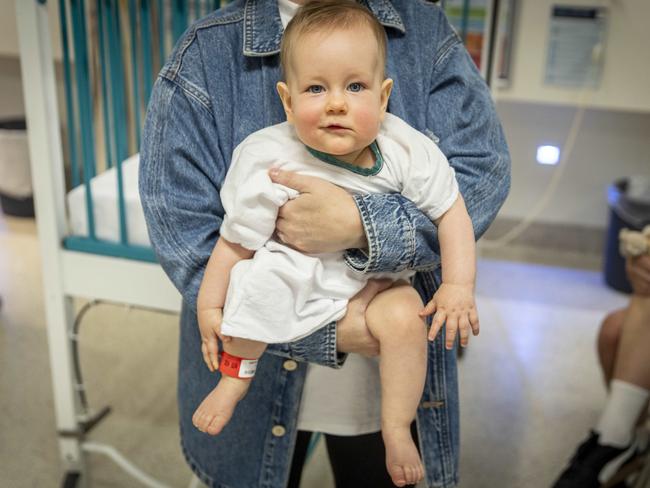
Professor Teague said Parker’s surgery would involve looking at both his breathing tube (trachea) and oesophagus, to see what might explain Parker’s choking and blue spell.
He explained: “(Parker’s) oesophagus might have narrowed at the join or been blocked by mucus, which could also impact his floppy trachea.”
Laurence, and his wife Claire, said Professor Teague’s ongoing treatment and care for Parker is immeasurable.
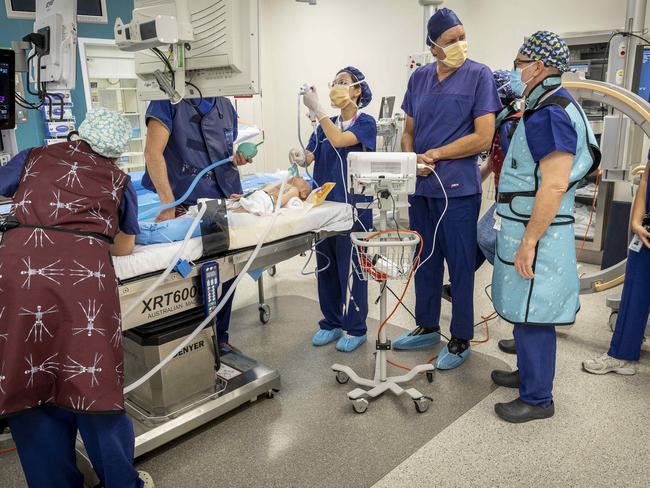
“It’s incredible what he’s done for our son,” Laurence said. “He’s given Parker the ability to eat, swallow — and live.”
An hour later, Professor Teague is in a different theatre conducting another huddle ahead of a hernia operation, a common surgery at the RCH.
This time, his patient is 9-months-old.
Another theatre, same hat.
“I’ve got a meeting in my research lab this afternoon. You’re very welcome to come along,” Professor Teague told us, then laughed: “Different hat.”
Originally published as Good Friday Appeal 2025: Little faces of courage ready to inspire Victoria


